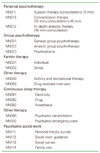A study on the relationship between non-pharmacological treatments and adherence to antidepressant pharmacotherapies in Korea
Article information
Abstract
Non-pharmacological treatments (NPTs) including psychotherapies and behavioral therapies have proven to be an effective treatment tool for patients with depression. More importantly, NPTs reduce drop-out rates for pharmacotherapy when combined with it. Given that one of the major obstacles to effective treatment of depression is low adherence to antidepressant therapies, NPTs deserve more attention in treating patients with depression. This study aims to analyze the current status of NPTs for patients with depression and the relationship with adherence to antidepressant therapies in Korea. The Health Insurance Review Agency (HIRA)'s claims database from 2006 to 2008 was used in the analysis and those patients with at least one inpatient diagnosis with depression or twice diagnosed in outpatient services were included in the analysis (n=290,188). NPTs were identified by HIRA treatment codes in each claim except a routine care treatment (HIRA treatment code, NN011). Adherence to antidepressant therapies was defined as 180-day medication possession ratio. The claims for NPTs decreased almost 25% in 2008 while the number of patients with depression and the claims for antide-pressants were consistently increasing during the same period. Those patients with claims for 4 or more NPTs showed a higher adherence rate than those without. The downward trend of NPT use deserves more attention since it may reduce adherence to pharmacotherapies and increase future medical costs through more relapses from the lowered adherence rates.




